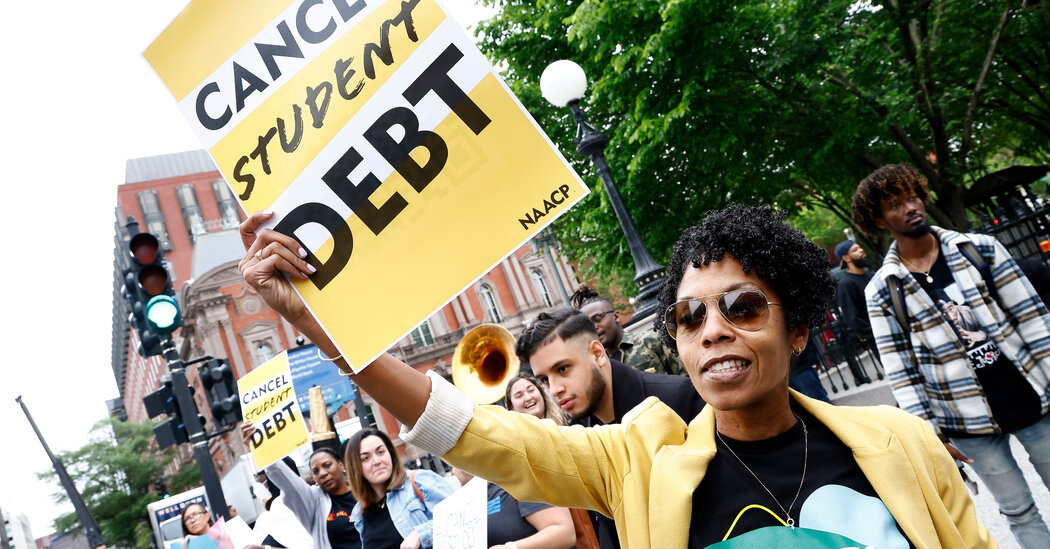
WASHINGTON — The soaring cost of food, gasoline and other staples is further complicating a fraught debate among President Biden and his closest advisers over whether to follow through on his campaign pledge to cancel thousands of dollars of student loan debt for tens of millions of people.
While Mr. Biden has signaled to Democratic lawmakers that he will probably move forward with some form of student loan relief, he is still pressing his team for details about the economic ramifications of wiping out $10,000 of debt for some — or all — of the nation’s 43 million federal student loan recipients.
In meetings this spring, Mr. Biden repeatedly asked for more data on whether the move would primarily benefit well-off borrowers from private universities who might not need the help, according to people involved in the process. The country’s 8.6 percent inflation rate, a four-decade high, has added another layer of complexity to the decision: What would it mean for the economy if the government forgives some $321 billion in loans?
“You’re talking about millions, possibly billions of dollars that could be spent. You should do it with eyes wide open,” said Cedric Richmond, who stepped down as a senior adviser to Mr. Biden last month. “He wants to make sure that it’s based in equity and it doesn’t exacerbate disparities.”
While Mr. Biden has yet to make a decision on student debt cancellation, his aides say he will before the end of August. The White House has been deeply divided over the political and economic effects of loan forgiveness. Mr. Biden’s chief of staff, Ron Klain, has argued that it would galvanize a base of young voters increasingly frustrated with the president. Other aides have presented data showing that many Americans who saved money to pay off tuition for themselves or their children would resent the move.
Some economic advisers have made the case to Mr. Biden that the move might actually relieve inflation, at least a little, if he pairs debt forgiveness to a restart of the interest payments on student loans, which have been paused since early in the pandemic.
Mr. Biden’s deliberations are emblematic of his attempts to straddle deep ideological divides in the country, often within his party. According to people familiar with his thinking, Mr. Biden is struggling to balance his promise to deliver sweeping proposals to address racial and economic disparities with concerns that loan cancellation would exacerbate inflation and be seen as a giveaway, undermining his image as a champion for labor and the working class.
Mr. Biden is considering a framework for student debt relief that his economic aides have assured him would not exacerbate inflation and could potentially ease price growth slightly.
Under the plan, Mr. Biden would cancel some debt for certain borrowers, likely up to $10,000 each, which would effectively give some of those borrowers more money to spend on goods and services, like buying furniture or dining out, potentially creating additional demand that could further push up prices. Any move to relieve debt would include some type of income limits on those who qualify.
But at the same time, he would end a pause on student loan interest payments for all borrowers, which was imposed in March 2020 and has been extended seven times, most recently until Aug. 31. That would effectively force many of those borrowers to spend less on goods and services to resume their loan payments.
Mr. Biden’s aides believe that pairing the two policies could pull a small amount of consumer buying power out of the economy. By some administration estimates, the two policies could bring inflation down very slightly. At minimum, aides say, they would cancel each other out.
“Given that fighting inflation is the president’s top domestic priority,” Jared Bernstein, a member of the White House Council of Economic Advisers, said in an interview, “the key economic fact here is that if debt payment restart and debt relief were to occur at roughly the same time, the net inflationary effect should be neutral.”
Designing a plan to be inflation-neutral, at worst, under the administration’s accounting would require limiting the debt relief to far less than what more liberal Democrats have pushed Mr. Biden to grant.
Opponents of debt cancellation would prefer Mr. Biden restart loan payments and not forgive any debt, which they say would have a better chance of dampening inflation. And they say the administration is making its inflation math appear rosier by looking at the resumption of interest payments as a new policy that could work as a counterbalance to canceling some debt, when the pause was always intended to be only temporary.
The administration’s math showing the paired policies to be neutral for inflation “is not the way I would prefer to think about it,” said Marc Goldwein, the senior policy director at the Committee for a Responsible Federal Budget, a nonpartisan fiscal watchdog group in Washington, and a critic of cancellation proposals. “But it’s not totally bizarre for somebody to think about it that way.”
Mr. Biden told reporters this week that he was close to making a decision on student debt. A White House official, speaking on the condition of anonymity to discuss internal discussions, said the administration wanted to wait until the end of August to assess how much of a problem inflation is by then, as well as any legislative movement in Congress.
The White House has said it would prefer that Congress pass legislation on student loan relief, but Senate Democrats lack the votes, leaving executive action as the only apparent pathway. And pressure is building from Democrats who want Mr. Biden to make good on his campaign promise.
During a White House meeting in May, Senators Elizabeth Warren of Massachusetts, Chuck Schumer of New York and Raphael Warnock of Georgia, all Democrats, presented data to Mr. Biden showing that debt cancellation would benefit borrowers who failed to obtain a degree to rebut the notion that relief would be a giveaway to the privileged, according to a person briefed on the meeting. Vice President Kamala Harris has also met with Mr. Biden to break down the groups that would benefit, another official said.
Democrats have often cited a report from Temple University showing that nearly 40 percent of full-time undergraduates who enrolled in the 2011-12 academic year accumulated some debt but did not have a degree after six years.
Republicans in Congress have attacked the White House as fiscally irresponsible. Representative Virginia Foxx of North Carolina, the top Republican on the Education and Labor Committee, said in a letter to the Education Department this month that she was “gravely concerned the department will further harm borrowers and taxpayers if it acts on student loan forgiveness, in part because of its inability to follow through on its grandiose proposals.”
Student Loans: Key Things to Know
Corinthian Colleges. In its largest student loan forgiveness action ever, the Education Department said that it would wipe out $5.8 billion owed by 560,000 students who attended Corinthian Colleges, one of the nation’s biggest for-profit college chains before it collapsed in 2015.
The department’s loan servicers are dreading a replay of what happened last year, when they sent borrowers a series of notices saying payments would restart after Jan. 31 — only to have the resumption of payments repeatedly delayed.
“Official direction is to march ahead as if it’s happening, since that’s what’s going to occur unless we actively hear otherwise,” said Scott Buchanan, the executive director of the Student Loan Servicing Alliance, a trade group, adding that servicers would start outreach to borrowers “in the next couple of months.”
The president might find less political gain than some aides imagine should he pursue the $10,000 forgiveness plan.
Some advocates for borrowers and labor groups have warned that moving forward with a limited form of relief with income caps could fuel more frustration among civil rights organizations and younger voters.
William E. Spriggs, a professor of economics at Howard University and chief economist for the A.F.L.-C.I.O., said that forgiving only $10,000 of debt would run counter to Mr. Biden’s commitment to racial equity. He said the limited cancellation would not be enough to address racial disparities in the economy, citing reports showing Black and other nonwhite borrowers end up with higher average loan balances than their white peers.
“You are answering the problem of white people,” Mr. Spriggs said. “If you do $10,000, you essentially are telling white people: ‘You’re OK. You don’t have any debt.’ That’s not the case with Black people.”
Debt forgiveness would benefit families of low-income households, he said, because they do not have as much access to universities with higher endowments and more lavish financial aid packages.
“This is the issue of everyday, regular Americans who went to their local, poorly supported state university who had to pay tuition,” Mr. Spriggs said. “And that means Black people.”
But by delaying the decision on student loan relief for months, others said Mr. Biden had already fueled a perception that student loan relief would be a giveaway to the privileged, rather than a matter of racial equity.
“By emphasizing these mythical Ivy Leaguers, he’s kind of put the wrong thought in people’s heads,” said Astra Taylor, a founder of the Debt Collective, which has lobbied the White House to cancel student loan debt. “If people believe that, I kind of blame the president.”

